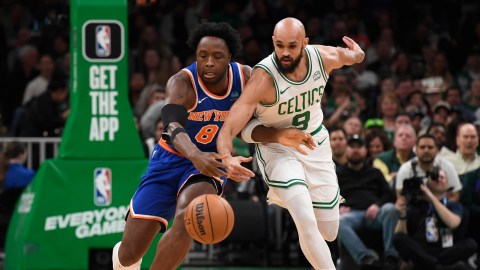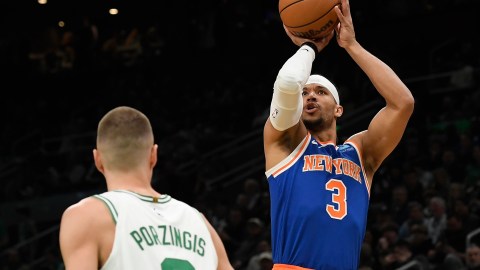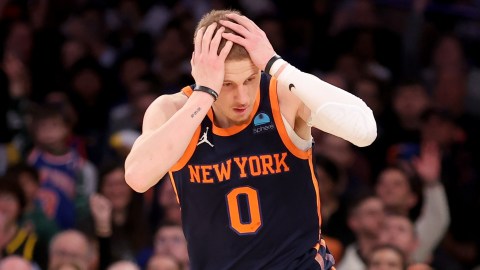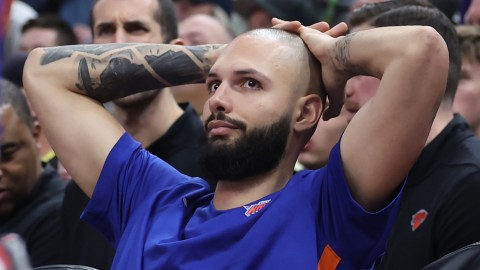 With one game-clinching play, LeBron James summed up everything that sets him apart from his peers while simultaneously revealing the Knicks’ greatest vulnerability.
With one game-clinching play, LeBron James summed up everything that sets him apart from his peers while simultaneously revealing the Knicks’ greatest vulnerability.
James’ steal-and-dunk, which turned a four-point nail-biter into a six-point sure thing for the Heat with 23 seconds left in Sunday’s game at Madison Square Garden, drew all the praise it deserved. His defensive read of J.R. Smith‘s lazy pass to Carmelo Anthony at the top of the key, coupled with the athleticism and reaction time to intercept the pass and rumble downcourt for the slam, was yet another example of the game’s greatest player performing at the top of his game.
Of course, James had several factors on his side, not the least of which is a 6-foot-9, 240-pound linebacker physique. Making his job even easier on that play was the Knicks’ own tendency to get predictable on offense of late — a tendency that has contributed to them losing five of their last eight games and falling a game behind Indiana for the second seed in the Eastern Conference standings.
The Knicks’ fascination with jump shots is nothing new. They attempt a league-leading 29.1 shots per game from beyond the arc and attempt fewer shots at the rim than all but nine other NBA teams. This might sound weird coming from the guy who complained earlier in the season that the Knicks were hitting threes at an unsustainable rate, but the Knicks really need to get back to that style, and fast. The longer they delay, the more they revert back to the Knicks of the last two seasons, who were less than the sum of their parts.
Nothing has captured the Knicks’ change like Tyson Chandler‘s offensive production. When New York busted out of the gates with a 21-9 record, Chandler averaged 12.0 points and 13.8 points, respectively, in the season’s first two months. He was facetiously labeled the best shooter in the game, since his single-minded purpose of only shooting within three feet of the rim garnered him the league’s best field goal percentage, and the rest of the team benefited. With Chandler diving toward the bucket on pick and rolls, defenses were forced the suck in and leave Smith, Steve Novak, Raymond Felton and occasionally Anthony open on the perimeter.
Since then, the Knicks have continued to fire away. But they have skipped the part that really made them successful: playing off Chandler and looking first for the dunk, then the three. They shot a season-high 30.6 threes per game in February, while Chandler’s shots per game fell to barely six per game. (At the height of his usage, simultaneous to the height of the Knicks’ success, he got a hair under eight shots per game.) Meanwhile, their 3-point percentage has fallen to .370, still among the top 10 in the league but short of the 40-plus percent they boasted before the New Year.
What does all of this have to do with the final meaningful play on Sunday, when Chandler was 20 feet from either Smith or Anthony when James picked off that pass? Nothing, except everything. In December, neither James nor anybody else would have felt comfortable extending that far out defensively, because a pass to Anthony at the top of the key probably would not have been the Knicks’ first action. The Knicks probably would have started with a Felton-Chandler pick and roll, possibly leading to Anthony posting up or coming off a Chandler screen to isolate his defender on the wing. There would have been moving parts, not stereotypical ‘Melo hero-ball, which is what the Knicks were undoubtedly gearing up for until James got in the way.
Before, there might have been uncertainty to keep James honest. James would have been watching Chandler out of the corner of his eye, or taking an extra look to make sure Jason Kidd was not spotting up somewhere in a soft spot on the perimeter. Yet in addition to being immensely gifted, James clearly did his homework. He recognized that these Knicks have become predictable, that Smith’s most likely course of action was to pass the ball to Anthony standing stationary at the top of the key, and that he could beat the ball to the spot because he is the best player on the planet.
Chandler took seven shots against the Heat, a team short on discernibly skilled big men. He made four of those shots, finishing with 10 points, to reach double figures in scoring for only the fourth time in the last 13 games.
With that, there were two lessons from this game. One, James is simply on a higher plane than anybody else in shorts. And two, the Knicks have forgotten who they are, and what put them in the discussion with the Heat in the first place.
Have a question for Ben Watanabe? Send it to him via Twitter at @BenjeeBallgame or send it here.



